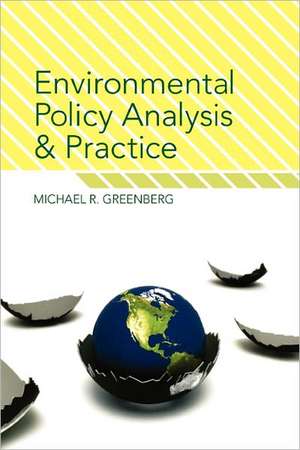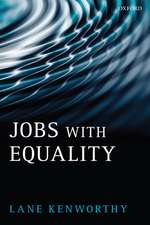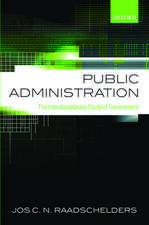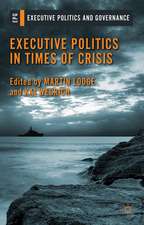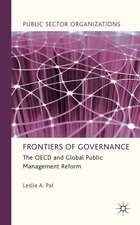Environmental Policy Analysis and Practice
Autor Michael R. Greenbergen Limba Engleză Paperback – 13 mar 2008
Pressing environmental challenges are frequently surrounded with stakeholders on all sides of the issues. Opinions expressed by government agencies, the private sector, special interests, nonprofit communities, and the media, among others can quickly cloud the dialogue, leaving one to wonder how policy decisions actually come about.
In Environmental Policy Analysis and Practice, Michael R. Greenberg cuts through the complicated layers of bureaucracy, science, and the public interest to show how all policy considerations can be broken down according to six specific factors: 1) the reaction of elected government officials, 2) the reactions of the public and special interests, 3) knowledge developed by scientists and engineers, 4) economics, 5) ethical imperatives, and 6) time pressure to make a decision.
The book is organized into two parts, with the first part defining and illustrating each one of these criteria. Greenberg draws on examples such as nuclear power, pesticides, brownfield redevelopment, gasoline additives, and environmental cancer, but focuses on how these subjects can be analyzed rather than exclusively on the issues themselves. Part two goes on to describe a set of over twenty tools that are used widely in policy analysis, including risk assessment, environmental impact analysis, public opinion surveys, cost-benefit analysis, and others. These tools are described and then illustrated with examples from part one.
Weaving together an impressive combination of practical advice and engaging first person accounts from government officials, administrators, and leaders in the fields of public health and medicine, this clearly written volume is poised to become a leading text in environmental policy.
The book is organized into two parts, with the first part defining and illustrating each one of these criteria. Greenberg draws on examples such as nuclear power, pesticides, brownfield redevelopment, gasoline additives, and environmental cancer, but focuses on how these subjects can be analyzed rather than exclusively on the issues themselves. Part two goes on to describe a set of over twenty tools that are used widely in policy analysis, including risk assessment, environmental impact analysis, public opinion surveys, cost-benefit analysis, and others. These tools are described and then illustrated with examples from part one.
Weaving together an impressive combination of practical advice and engaging first person accounts from government officials, administrators, and leaders in the fields of public health and medicine, this clearly written volume is poised to become a leading text in environmental policy.
Preț: 360.63 lei
Nou
Puncte Express: 541
Preț estimativ în valută:
69.01€ • 74.94$ • 57.97£
69.01€ • 74.94$ • 57.97£
Carte tipărită la comandă
Livrare economică 22 aprilie-06 mai
Preluare comenzi: 021 569.72.76
Specificații
ISBN-13: 9780813542768
ISBN-10: 0813542766
Pagini: 320
Ilustrații: 1
Dimensiuni: 156 x 235 x 18 mm
Greutate: 0.45 kg
Ediția:None
Editura: Rutgers University Press
Colecția Rutgers University Press
ISBN-10: 0813542766
Pagini: 320
Ilustrații: 1
Dimensiuni: 156 x 235 x 18 mm
Greutate: 0.45 kg
Ediția:None
Editura: Rutgers University Press
Colecția Rutgers University Press
Notă biografică
Michael R. Greenberg has studied environmental policy for almost forty years and is a professor and associate dean at the Edward J. Bloustein School of Planning and Public Policy at Rutgers University. He is the author and coauthor of numerous books, including The Reporter's Environmental Handbook (Rutgers University Press).
Cuprins
The reaction of elected officials and staff criterion : the brownfields redevelopment policy
The reaction of nongovernment stakeholder groups criterion : environmental cancer and cancer clusters
Scientist stakeholder criterion : gasoline additives
Economic criterion : costs of environmental management
Ethics criterion : international trade in pesticides and genetically modified crops
Time and flexibility criterion : nuclear power revisited
Policy measurement and assessment tools
Decision-making and communication tools
The reaction of nongovernment stakeholder groups criterion : environmental cancer and cancer clusters
Scientist stakeholder criterion : gasoline additives
Economic criterion : costs of environmental management
Ethics criterion : international trade in pesticides and genetically modified crops
Time and flexibility criterion : nuclear power revisited
Policy measurement and assessment tools
Decision-making and communication tools
Descriere
Pressing environmental challenges are frequently surrounded with stakeholders on all sides of the issues. Opinions expressed by government agencies, the private sector, special interests, nonprofit communities, and the media, among others can quickly cloud the dialogue, leaving one to wonder how policy decisions actually come about.
In Environmental Policy Analysis and Practice, Michael R. Greenberg cuts through the complicated layers of bureaucracy, science, and the public interest to show how all policy considerations can be broken down according to six specific factors: 1) the reaction of elected government officials, 2) the reactions of the public and special interests, 3) knowledge developed by scientists and engineers, 4) economics, 5) ethical imperatives, and 6) time pressure to make a decision.
